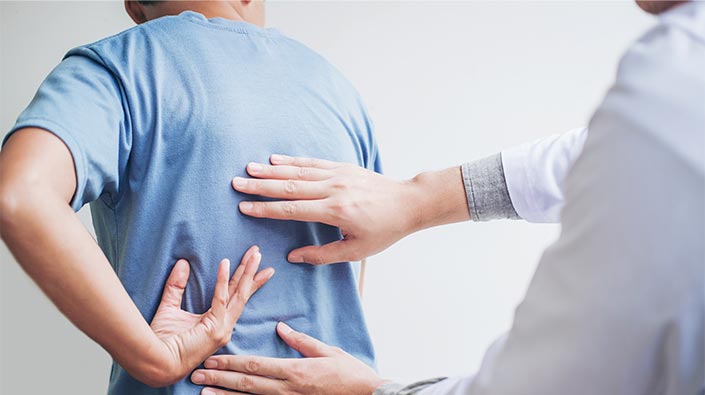Conditions Treated by the Inova Spine Program
Below are some of the spine conditions expertly treated by the professionals within the Inova Spine Program.
Low Back Pain
Low back pain is by far the most common spinal complaint among adults in the United States. It affects the back anywhere below the ribs and above the legs. Causes include overuse, strain, injury, compression fracture, aging, and diseases such as arthritis and osteoporosis.
Treatments for low back pain vary according to severity and include:
- Medication
- Physical therapy
- Laminectomy
- Spinal fusion
- Epidural steroid blocks
- Selective nerve root blocks/transforaminal epidural steroid blocks
- Facet blocks
Sciatica
Sciatica is pain, tingling or numbness caused by irritation of the sciatic nerve in the lower back. It can result from a herniated disc pressing against the nerve roots, spinal stenosis, arthritis or an injury-induced pinched nerve.
Treatments for sciatica include:
- Medication
- Physical therapy
- Laminectomy
- Spinal fusion
- Epidural steroid blocks
- Selective nerve root blocks/transforaminal epidural steroid blocks
- Sympathetic blocks
Radiculopathy
Radiculopathy is a disease of the spinal nerve roots and spinal nerves. Cervical radiculopathy affects the nerve roots near the neck and radiates through the arms and hands. Lumbar radiculopathy causes nerve irritation in the lower back that radiates through the legs and feet. Wear and tear, degeneration, herniated discs and traumatic injury are the primary causes.
Treatments for radiculopathy include:
- Physical therapy
- Epidural steroid blocks
- Selective nerve root blocks/transforaminal epidural steroid blocks
Lumbar Disk Disease
Your lumbar spine, or low back, is made of five vertebrae separated by cushioning disks of cartilage. Degenerative conditions or trauma can damage a disk, allowing the material inside to bulge into the spinal canal. This video discusses the effects of this bulging or herniated disk.
Treatments for a herniated disk include:
- Medication
- Physical therapy
- Artificial disk replacement
- Spinal fusion
- Laminaplasty
- Microendoscopic discectomy
- Epidural steroid blocks
- Selective nerve root blocks/transforaminal epidural steroid blocks
Cervical Disk Rupture
The vertebrae in your spine are cushioned by soft disks. When one of the disks in your neck – the cervical area of your spine – ruptures, the result can be neck pain. Watch this video to find out the possible causes and recommended treatment
Spinal Stenosis
Spinal stenosis is a condition in which the spinal canal narrows and pinches the nerves, resulting in back and leg pain. Spinal stenosis often occurs in older adults, although younger people who are born with a small spinal canal may also develop symptoms. This video explains the condition and what treatments are recommended.
Treatments for spinal stenosis include:
- Medication
- Physical therapy
- Laminaplasty
- Laminectomy
- Spinal fusion
- Interspinous/interlaminar implant
- Epidural steroid blocks
- Selective nerve root blocks/transforaminal epidural steroid blocks
Degenerative Disk Disease
Most vertebrae are separated by flexible disks of cartilage that act like shock absorbers and allow your spine to move. With age, your disks can lose their height and ability to cushion. This process is called disk degeneration. This video explains more about this condition and the treatments available.
Treatments for degenerative disc disease include:
- Medication
- Physical Therapy
- Artificial disc replacement
- Spinal fusion
- Epidural injections
- Epidural steroid blocks
- Selective nerve root blocks/transforaminal epidural steroid blocks
Arthritis of the Spine
Arthritis in the lower back and pelvic area can cause pain and loss of motion. See how this arthritis develops, who's at risk, and what treatments can help.
Cervical Arthritis
Your neck is the upper or cervical part of your spine, a column of 33 bones called vertebrae. Cervical arthritis is a condition that occurs when the cartilage and vertebrae in the neck wear abnormally. This video explains how the condition develops and what treatments are available.
Spondylolisthesis
Spondylolisthesis is a forward slip of one vertebra in the spinal column and usually occurs in the lumbar region. Some people are born with a defective vertebra; in others, trauma, a stress fracture, infection or disease may cause the problem. The condition is on the rise among children and adolescents who are active in athletics.
Spondylolisthesis treatments include:
- Physical therapy
- Spinal fusion
- Epidural steroid blocks
- Selective nerve root blocks/transforaminal epidural steroid blocks
Myelopathy
Myelopathy is the gradual loss of nerve function caused by disorders of the spine. The condition commonly results from spinal injury or spinal stenosis, a progressive narrowing of the spinal canal.
Myelopathy treatments include:
- Medication
- Physical therapy
- Laminectomy
- Spinal fusion
Scoliosis
Scoliosis is a condition that causes the spine to curve sideways. It can develop during childhood or adolescence and can range from mild to severe. This video explains how scoliosis occurs and what treatments are available.
Scoliosis treatments include:
- Physical therapy
- Spinal fusion
- Facet blocks
Kyphosis
Kyphosis is a progressive disorder that causes curvature of the thoracic spine in children and adults. It is most often the result of developmental problems, trauma, degenerative diseases (such as arthritis) or osteoporosis with compression fractures.
Treatments for kyphosis include:
- Physical therapy
- Spinal fusion
Ankylosing Spondylitis
Ankylosing spondylitis is a form of arthritis that primarily affects the ligaments and joints of the spine, especially the lower back. As the disease progresses, it can lead to a stooped posture. In this video, you'll find out how this condition develops and the treatments available.
Compression Fracture
A compression fracture is a broken vertebra in the spine. It usually occurs due to severe trauma, but is also the result of cancer or osteoporosis. Compression fractures are most common in the vertebrae of the lower back.
The treatment for a compression fracture is kyphoplasty.
